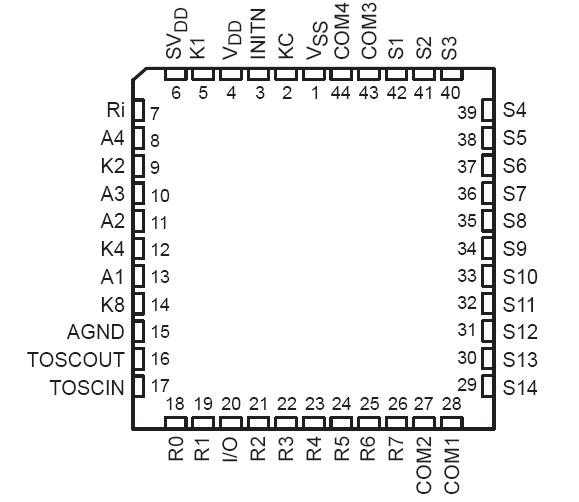Features: • 12-Bit ADC With 4 Multiplexed Inputs
• Wide Supply Voltage Range
2.6 V to 5.5 V
• Low Power Consumption at VDD = 3 V
0.1 mA in Off Mode (Typ)
4 mA in Done Mode (Typ)
80 mA in Active Mode Without A/D
C onversions (Typ)
300 mA in Active Mode With A/D
Conversions (Typ)
• On-Board 4-Multiplex 56-Segment LCD Driver
• Easy Analog Interface From 0.2 * SVDD to
0.4 * SVDD Analog Input Range
• On-Board Ratiometric Current Source
Programmable From 0.15 mA * (SVDD/V) to
2.4 mA * (SVDD/V)
• Two Independent 32.768-kHz Crystal
Controlled Timers
• Internal MOS Oscillator Serves as System Clock
• Programmable Microcontroller
• 960 Bits of Static RAM With 12 Internal Data
Storage Registers
• Simple and Easy Programming With
SMPLE Macro Language
• 4K Bytes of ROM Preprogrammed With
SMPLE Macro Language Interpreter
Memory Bank SwitchingPinout SpecificationsSupply voltage range, VDD (see Note 1) . . . . . . . . . . . . . . . . . . . . . . . . . . . . . . . . . . . . . . . . . . .0.3 V to 7 V
SpecificationsSupply voltage range, VDD (see Note 1) . . . . . . . . . . . . . . . . . . . . . . . . . . . . . . . . . . . . . . . . . . .0.3 V to 7 V
Input voltage range, VI . . . . . . . . . . . . . . . . . . . . . . . . . . . . . . . . . . . . . . . . . . . . . . VSS 0.3 V to VDD+0.3 V
Diode current . . . . . . . . . . . . . . . . . . . . . . . . . . . . . . . . . . . . . . . . . . . . . . . . . . . . . . . . . . . . . . . . . . . . ± 2 mA
Operating free-air temperature range, TA:TSS400CFN-S2 . . . . . . . . . . . . . . . . . . . . . . . . . . . . . . 0°C to 70°C
TSS400QFN-S2 . . . . . . . . . . . . . . . . . . . . . . . . . . . . . . . . . . . . . . . . . . . . . . . . . . . . . . . . . . . . 40°C to 105°C
Storage temperature range . . . . . . . . . . . . . . . . . . . . . . . . . . . . . . . . . . . . . . . . . . . . . . . . . . .50°C to 150°C
† Stresses beyond those listed under "absolute maximum ratings" may cause permanent damage to the device. These are stress ratings only and
functional operation of the device at these or any other conditions beyond those indicated under "recommended operating conditions" is not
implied. Exposure to absolute-maximum-rated conditions for extended periods may affect device reliability.
NOTE 1: The voltage value is measured with respect to VSS.DescriptionThe TSS400CFN sensor signal processor is an ultra-low power, intelligent, 12-bit analog-to-digital converter (ADC) that has been preprogrammed with the Sensor Macro Programming Language (SMPLE) interpreter. This language allows fast, easy, and economical customization of the TSS400CFN to a wide range of sensor signal processing applications. Some of the typical applications include:
• Temperature measurements with calculating, controlling, and warning features
• Pressure and acceleration measurements
• Timers with control functions
• Intelligent keyboard and display drivers
The application-specific programs that customize the operation of the TSS400CFN are stored in external EEPROMs along with additional data required by the application. The main components of the TSS400CFN are a four-input multiplexed 12-bit ADC, a programmable constant-current source, an LCD driver capable of driving 56 segments using a four-multiplex drive scheme, two crystal-controlled independent timers, an on-board RAM, six output-only terminals (R1 to R6), a 4-bit programmable I/O port (K1, K2, K4, K8), and I2C serial EEPROM communications. Using the TSS400-S2 is very easy because it is controlled by a SMPL language program.
These programs can be stored in an external EEPROM (stand-alone mode) or stored in a host computer (slave mode). The SMPL language is a powerful, easy-to-learn, and easy-to-use macro language. Some SMPL language features include single-command EEPROM read and EEPROM write operations, three levels of subroutines, a single-command A/D conversion instruction that specifies the numbers of conversions and the types of conversions (either compensated or noncompensated), and two reduced power consumption modes (done and off ).

 TSS400CFN Data Sheet
TSS400CFN Data Sheet







